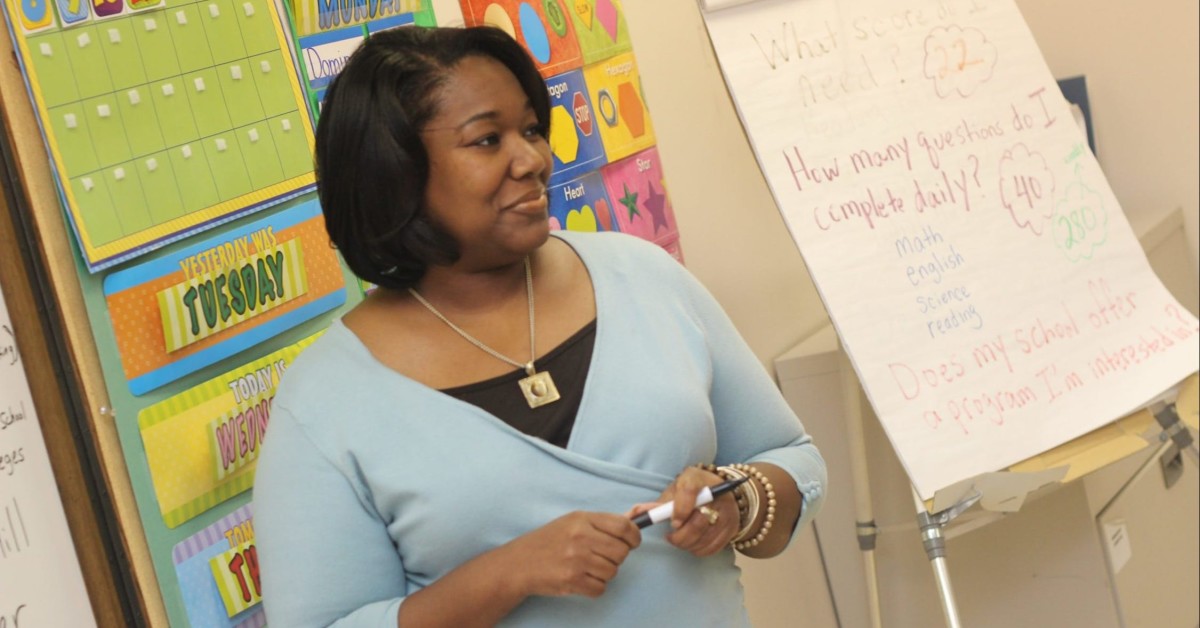
Are There Online Teacher Residency Programs?
The beauty of online teacher residency programs is that after [...]
School leaders were convinced that these new practices would enable them to achieve the school’s mission of providing strong academics and an inclusive community in which all students received support.
What did it choose? An instructional approach known as the “Responsive Classroom” (RC).
Like many parents, I had not heard of RC, and I wondered how it would affect classes, academics, and our kids. Fortunately, children at the school — including my own — have benefited greatly. RC has helped them develop strong student-teacher relationships, academic abilities, and interpersonal skills. Moreover, the approach has helped reduce bullying and promoted a culture of inclusion for all children, especially those who have special needs like mine.
Responsive Classroom Overview
The Responsive Classroom was established in 1981 by a group of public elementary school teachers who sought an educational approach that would go beyond traditional academic experiences, with the goal of integrating social and academic growth throughout the school day. They founded the Center for Responsive Schools (CRS), and by 1997, CRS had begun offering professional development to teachers and school staff interested in learning the principles of an educational approach that leads to “greater teacher effectiveness, higher student achievement, and improved school climate.”
According to its website, RC comprises a research-based set of learning practices that are principally founded on four components:
Engaging Academics
Academic studies are designed to be interactive, geared towards student interests, and educationally challenging.
Positive Community
Teachers foster a sense of belonging and safety so that each student is comfortable and able to express herself.
Effective Management
Teachers create calm yet orderly environments that promote autonomy and learning.
Developmental Awareness
Teachers establish developmentally appropriate learning environments for every student.
As these tenets suggest, RC is not simply an approach that schools can implement in an offhand manner. Rather, teachers and administrators attend an initial formal professional development seminar that lasts a week. After this series of sessions, the founding organization is available to provide follow-up coaching, assessment, conferences, study kits, and more.
Responsive Classroom Practices
Since our children are fortunate enough to attend a school that has fully integrated RC into its day-to-day operations, I’ve seen firsthand how administrators and teachers have implemented each of the four foundational principles.
Engaging Academics
While the instructors design a curriculum that follows state learning standards like the Common Core, the children have input into the lessons themselves. For example, a teacher may present a range of options for a project and let the students decide which specific topic they want to work on. Teachers are not bound by their individual classrooms, nor are students confined to desks. Group activities can take place anywhere on school grounds, and there is also a generous helping of off-site learning during regular field trips to practice gardening, hiking, or investigating local historical sites.
Positive Community
RC professional developers train educators to lead a practice called “Morning Meetings.” These events happen daily at the classroom level and weekly schoolwide. At the beginning of the day in each class, students meet for a few minutes as a group to talk about different topics and share their feelings. In the early grades, teachers help kids learn to take turns. One of our teachers demonstrates this by allowing each speaker to hold a ball. When a student is finished, she then passes the object to the next child in order to give her a turn sharing. Morning Meetings can also integrate assistive technology to enable children with special needs to take part fully. For example, my daughter has low verbal skills, but she can use her iPad to communicate her thoughts and feelings.
In addition to the weekly meetings held for the entire school community, there are also occasional grade-level gatherings that serve to foster bonds among students in different classes. There are over 300 children in our kids’ K–5 school, but most of them know each other, some quite well. The children are not bound by the classroom divisions or lunchroom cliques often seen in traditional schools, in part because the students have frequent positive interactions with their peers in other classes. One year, for example, my older daughter was rewarded with a photo in front of the “Kindness Wall” for demonstrating great care towards another student. This type of acknowledgement may take different forms at each grade level, but it is an integral part of the RC culture.
Effective Management
Responsive classroom places considerable responsibility on teachers for creating a culture that fosters teamwork and academic growth. The educators at our school are excited to put their creative skills to use meeting this challenge. That said, to integrate RC successfully, teachers need time to discuss and coordinate planning without children present, so our school releases students two hours early on Wednesdays. Teachers then use this block of the day to design curriculum plans that meet grade standards aligned with the RC approach.
Developmental Awareness
Although both of my children have either a paraprofessional or a special education teacher, each of my kids is as integrated as possible, remaining in her classroom for all instruction and every project unless there is a problem or a need for extra educational support or therapy.
Teacher awareness is critical to making this successful. A few years ago, we had a meeting with our daughter’s second-grade teacher when our child was struggling with meltdowns and mildly aggressive behaviors. The classroom teacher told me that her concern was not only for the children, but for Zoe as well; this educator wanted to ensure that our daughter’s classmates saw her as a peer, and not as a child with a problem. Without identifying specific students, the teacher made strategic recommendations based on her knowledge of all the kids in the class. Eventually, we found a plan that worked to integrate my daughter successfully while simultaneously teaching her to respect the other children. In the end, this was one of her best school years, especially for making friends.
Promoting Community
One of the most distinctive characteristics of responsive classrooms is the care and responsibility taught through the use of reinforcing language, as distinct from just a “positive” approach. According to its website, educators are taught to replace general negative or positive assessments of student work with encouragement for specific skills that these children demonstrate. RCS offers these suggestions to illustrate the concept:
Instead of …
“You need to work harder at your writing, Mia. You just don’t stick with it long enough.”
Try …
“You worked longer at your writing today, Mia. What helped you to do that?”
Instead of …
“What a great piece of writing!”
Try …
“You used lots of describing words. That will really help readers “see” your story!”
As teachers model these interactions, students in turn learn to notice the work of other children and comment with precise details. This practice reduces both negative criticism and flattery, highlighting instead concrete strengths a child can build on to deepen her achievement.
This culture of observing others supportively also leads kids to jump in when there is a problem. Recently, my daughter was having a difficult day, and two other girls gave up their lunch to help her — a pretty amazing step for hungry seventh-graders to take! In fact, our new social studies teacher told me that in all his years of teaching, he’d never seen students as supportive and cooperative as they are in our school.
A Solution to Classroom Bullying
The National Education Association reported in 2012 that “one in three American schoolchildren in grades six through 10 are affected by bullying. 83 percent of girls and 79 percent of boys report experiencing harassment.” Bullying in school is a serious issue, and RC offers one model for addressing this widespread problem. By showing teachers how to create safe, inclusive classrooms, these educators enable kids to be themselves, build community, and develop both social-emotional and academic skills. As RC describes its approach,
Teachers use modeling and role playing to teach positive social behaviors, and they strengthen social learning by connecting it with academic studies … Teachers also encourage reflective discussion about what behaviors children think are working well and where they could improve.
My children’s school has not been 100 percent bully-free over the years, but the incidents have certainly diminished as teachers adopted and integrated these practices into their own classrooms.
The Impact on Academics
Some parents may wonder how strong student achievement is in responsive classrooms. After all, community building, socialization, and Morning Meetings are central to the RC approach, and it may seem as if these practices would leave insufficient time for instruction. A study conducted by the University of Virginia’s Curry School of Education between 2008–2011 found that, “on average, students exposed to Responsive Classroom practices for three years showed a 12 percentile gain in math and reading achievement.” The researchers concluded that teachers who had adequate training and support in RC and implemented the approach properly boosted academic achievement in these areas, as well as improved interactions with their students.
Personally, I’ve seen my children thrive academically. Though each of our daughters has an Individualized Education Program (IEP), adaptations, and a host of learning disabilities and speech-language challenges, they are both performing exceptionally well at age-appropriate academics. Most importantly, they actually enjoy school, doing their coursework, and seeing their friends. I’m convinced that responsive classroom is an educational approach that benefits teachers, students, and parents by creating an inclusive atmosphere in which children can learn and thrive.
Questions or feedback? Email editor@noodle.com

The beauty of online teacher residency programs is that after [...]

Special education can be a highly competitive major, meaning that [...]
![There were times in my first year of teaching when I felt like nothing I was doing worked. I felt like leaving the classroom and never coming back. I have since then learned several strategies to build a supportive class culture and manage students in ways that promote healthy relationships. Building a Class Culture Takes […]](https://resources.noodle.com/wp-content/uploads/2024/01/pexels-pixabay-289737-default-scaled.jpg)
Categorized as: Teaching, Education & Teaching